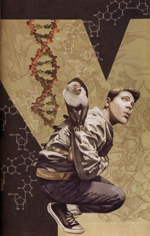
Unmanned
"Do you ever think about destiny? (1.7.3)
Brian K. Vaughan's and Pia Guerra's Y: The Last Man (2003)
Points for Reflection
Y: The Last Man, issues #1-5 (6-130)
- what rhetorical and aesthetic choices has Pia Guerra, the illustrator, made when depicting various genders, ethnicities, and nationalities?
- do the male characters introduced in Issue #1 betray any sexual prejudices, subtle or overt, when interacting with women?
- Yorick claims that he and his sister have grown into the odd names given them by their father, names pulled from plays by Shakespeare. His sister, as an Emergency Medical Technician, practices a heroic profession, and he has become “‘a worthless joker’” like the jester in Hamlet whose skull the prince of Denmark finds in an open grave (91.5). Do you agree, is Yorick more a joker than anything else, and is Hero a valiant, heroic woman?
- what set of skills must Vaughan give to his male hero to ensure his survival following the cataclysm?
- which women appear devoted to equal rights, and what visible, tangible various forms do these egalitarian principles actually take?
- does Representative Brown fit neatly into any particular stereotypes?
- are Colonel Tse’Elon and Agent 355 equally comfortable with violence?
- why does Colonel Tse’elon remain in her profession post-apocalypse?
- why does Dr. Mann choose to bear a clone?
- does the world described in Issue #1 (7-38) appear to be deserving of a cataclysm that might shake up its notions concerning gender?
- what professional inequities do the stats handed to the reader at the end of Issue #1 highlight (22), and what does this suggest about which goods and services will be hardest hit by this catastrophe?
- in what ways do women appear to be better off in Issue #2? Worse off?
- can you identify many of the pop culture allusions and cultural references made by Yorick and others? Do these moments make the text more, or less, accessible and relevant to today’s reader?
- does the quick assessment of the Amazons delivered by the rock-lamenting woman whom Yorick meets at the Washington Monument ring true in the series’ subsequent issues, or are we meant to sympathize with this particular manifestation of feminism?
- why do women join the Amazons?
- when we first meet Victoria, she tells Chloe to get off her knees—that they’re all equal (107.1-2). Does her treatment of fellow Amazons match her rhetoric?
- does the cataclysm iron out the socioeconomic wrinkles characterizing pre-event America?
- does racial prejudice vanish along with men?
- what happens to female sexuality in the absence of men? Do Vaughan's suggestions seem plausible?
- does this tale suggest that belligerence is a gendered trait?
- which makes more sense to you, the demands made by the Republican wives of dead senators that they occupy their husband’s seats, or Representative Brown’s observation that they can do more good in their communities than they can inside the Capitol—until special elections can be held (73.3-5)?
- does this story seek to privilege either a conservative or liberal perspective?
- is Yorick's dedication to his girlfriend sweet or ridiculous in light of the new set of circumstances handed him by the cataclysm?
- does this graphic novel suggest that women alone can create a better society than previously existed? Does the answer to this question depend on the nation in question?
- does Brian K. Vaughan's story reinscribe old sexual stereotypes, or seek to explode them?
- does the book engage the God & faith question, either directly or indirectly?
- are this novel's attempts at humor effective?
- why might Vaughan provide his characters with such an arsenal of curse words?
Julia Alvarez's "Heroics" (May, 1982), PDF
- what emotion bookends this poem?
- does Alvarez title her poem wistfully, ironically, or seriously?
- is the antecedent of "you" the narrrator herself, her mother, fellow poets, or someone else?
- what does the preceding generation apparently value above all other things, when considering the futures of their daughters? What has this new fetish replaced?
- does the narrator agree with the claim that education confuses the current, younger generation's goals and sense of self?
- what do the narrator and her fellow writers send back to their parents who still live in, presumably, the Dominican Republic (the author's nation of origin) and other parts of the Caribbean?
- what unlooked-for effect do the advertisements in popular American magazines sometimes have on the narrator?
- are the narrator and her ilk able to meet any of the expectations of their mothers and families of origin?

cover art for Y: The Last Man
J. G. Jones or Massimo Carnevale
Dr. Paul Marchbanks
pmarchba@calpoly.edu
![]()
